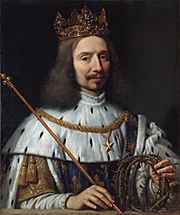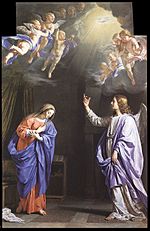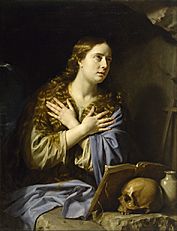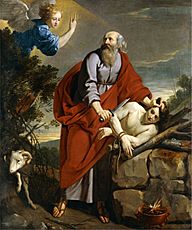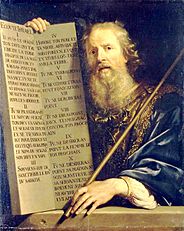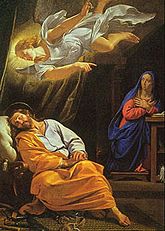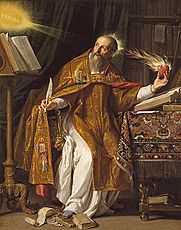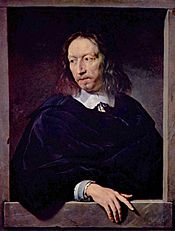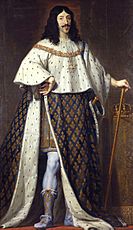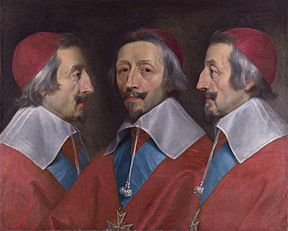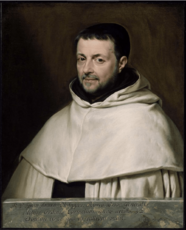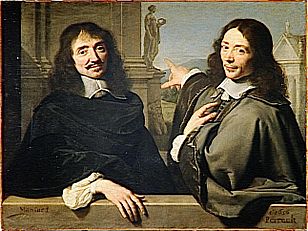Philippe de Champaigne facts for kids
Quick facts for kids
Philippe de Champaigne
|
|
|---|---|
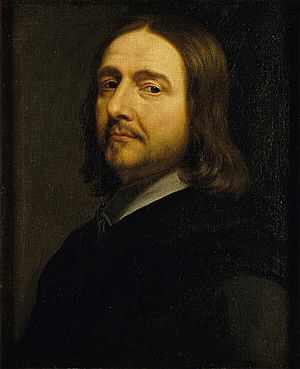
Philippe de Champaigne, self-portrait.
Museum of Grenoble |
|
| Born |
Philippe de Champaigne
26 May 1602 |
| Died | 12 August 1674 (aged 72) |
| Known for | Painting |
| Movement | Baroque |
Philippe de Champaigne (born May 26, 1602 – died August 12, 1674) was a famous French painter from the Baroque period. He was born in Brussels, which was then part of the Southern Netherlands. Philippe de Champaigne was a very important artist in the French school of painting. He also helped start the Académie royale de peinture et de sculpture in Paris, which became the most important art school in France.
Contents
Life and Work of a Master Painter
Philippe de Champaigne was born into a family that was not rich, in Brussels. When he was young, he learned to paint from a landscape artist named Jacques Fouquières. In 1621, he moved to Paris, a big city in France.
Starting His Career in Paris
In Paris, Philippe de Champaigne worked with another famous painter, Nicolas Poussin. They helped decorate the Palais du Luxembourg, a large palace. Their boss was Nicolas Duchesne. Later, Philippe de Champaigne married Duchesne's daughter.
Some stories say that Duchesne became jealous of Champaigne's growing fame. Because of this, Champaigne went back to Brussels for a short time to live with his brother. He only returned to Paris after he heard that Duchesne had passed away.
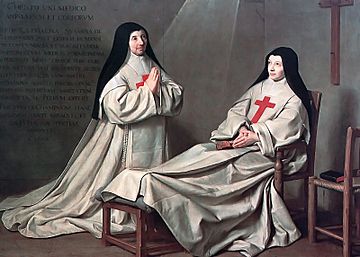
After Duchesne's death, Champaigne began working for the Queen Mother, Marie de Medicis. He helped decorate the Luxembourg Palace for her. He also painted several artworks for the Notre Dame Cathedral in Paris, starting around 1638. He even designed pictures for tapestries, which are woven wall hangings. The Queen made him her first painter and gave him a good salary. He also decorated the Carmelite Church of Faubourg Saint-Jacques, which was one of the Queen Mother's favorite churches.
Many of the buildings he decorated were destroyed during the French Revolution. However, some of his paintings from these places are now safe in museums. For example, The Presentation in the Temple is in Dijon, The Resurrection of Lazarus is in Grenoble, and The Assumption of the Virgin is in the Louvre.
Working for Important People
Philippe de Champaigne also worked for Cardinal Richelieu, a very powerful leader in France. He decorated Richelieu's palace, the Palais Cardinal, and the dome of the Sorbonne university. Champaigne was the only artist allowed to paint Richelieu wearing his cardinal robes. He painted him this way eleven times!
In 1648, Champaigne became a founding member of the Académie de peinture et de sculpture. This was a very important art school and institution in France.
Later in his life, starting around 1640, Champaigne was influenced by a religious movement called Jansenism. His daughter became paralyzed, but she was later said to have been miraculously cured at a nunnery called Port-Royal-des-Champs. After this, he painted a famous picture called Ex-Voto de 1662. This painting shows his daughter with the Mother-Superior of the nunnery.
Champaigne's Artistic Style and Legacy
Philippe de Champaigne created a huge number of paintings. Most of his works were religious scenes or portraits of people.
His Unique Painting Style
At the beginning of his career, Champaigne was influenced by the famous painter Rubens. But over time, his own style became simpler and more serious. Philippe de Champaigne is known for the bright colors in his paintings and the strong, clear way he put his pictures together.
He painted portraits of many important people in France. This included the royal family, high-ranking nobles, church leaders, government officials, and famous architects. He captured their personalities without showing fleeting expressions.
One interesting portrait he made was of the poet Vincent Voiture. Champaigne later changed this portrait to show Voiture as a religious figure, Saint Louis (King Louis IX). He did this so Voiture's daughter could keep the painting with her when she joined a convent.
Where to See His Art
You can find Philippe de Champaigne's paintings in many public buildings, private collections, and churches. Some of these include Val-de-Grâce, Sorbonne, Saint Severin, Saint-Merri, Saint-Médard, and the Basilica of Notre-Dame du Port in Clermont-Ferrand.
He was so famous that he was even mentioned in the play Cyrano de Bergerac!
Champaigne also taught many students. Some of his pupils were his nephew Jean Baptiste de Champaigne, William Faithorne, Jean Morin, and Nicolas de Plattemontagne. In his later years, Champaigne mostly painted religious subjects and portraits of his family. He passed away in Paris in 1674.
Gallery
- Selected works
-
The Annunciation, around 1645, Wallace Collection
- Portraits
-
Portrait of Arnauld d'Andilly, 1650, Louvre
-
Triple portrait of Cardinal de Richelieu, around 1642, National Gallery, London
-
Portrait of Jean-Baptiste Colbert, 1666
-
Reverend Father Giovanni Antonio Philippini (1651) Museum of Fine Arts, Boston
-
Double portrait of François Mansard and Claude Perrault, 17th century, attributed
See also
 In Spanish: Philippe de Champaigne para niños
In Spanish: Philippe de Champaigne para niños





